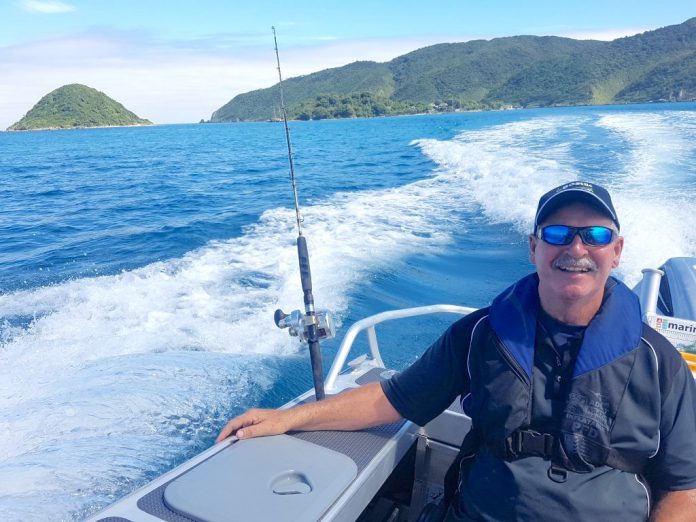By Bostik Gone Fishin presenter and Building Today columnist Graeme Sinclair
Recently we filmed the lead story for
Bostik Gone Fishin
Series 25 — a flat calm day on an ocean like glass.
It also coincided with a full moon — and that big old moon is often accompanied by slow fishing. Monday did not prove to be any exception.
We were late, and by the time we filmed a few introductory sequences other people were heading home.
Out in the Tiri Channel two kayakers were retrieving their anchored burley pot and then paddled over for a chat. They had opted to take three fish between two and three kilos.
“More than enough for us!” they said. “We’ll get three feeds out of this and smoke the biggest one.”
Their technique included anchoring a burley pot, allowing time for the chum to drift down current, and then silently drifting down the trail. Very smart, I thought, and productive.
As they paddled away we drifted down their trail, put a nice snapper in the bin and dumped a couple of others.
The two Grants and I had no bait. We were using kaburras and soft baits, pieces of “fishing bling” that can be lethal.
Our late start was not very smart! Fishing is hunting, and on the moon, early morning and late evening tend to be the most productive.
We have known each other for a very long time, and through the lengthy quiet periods reflected on the many changes we had seen over the past 25 years.
The bait boys of yesteryear would go home with a clean boat thanks to the polished lures that dangled in the depths.
A new brand of soft bait called “Liveys” succumbed to a twitching rod while I occasionally lowered a kabura.
The technique used to fish “Liveys” relies on movement. Visualise the erratic action of a wounded bait fish, the way they flutter, swimming up then falling away again before once more trying to appear “normal”.
That is what you need to impart to your jig head and soft bait. Movement is the key, and staying in touch with what is happening. As soon as you sense that the line is tightening or that there is a change, strike!
This is particularly true on days like those over the moon when the take can be tentative.
At other times you don’t even have to think — the fish just explode all over the “bait” and the non-stretch braid ensures an immediate hook up.
I just love that huge shunt of adrenalin that courses through your system at the moment your day just got a whole lot better. Soft baiting, by the way, supplies adrenalin in spades!
Other important considerations are weight of jig head plus size, colour and even shape of bait. Experiment!
A lot of people tell me that they have tried soft baits and they didn’t work. The answer: “try again!”
The first day I caught the bug I was anchored over a structure in the Bay of Islands.
Fishing was slow, although the previous night we had filmed some great action on live baits in the same place.
The sounder was lit up with snapper sign, but they no longer wanted anything to do with liveys.
At some point I remembered the very small rod and reel tucked inside the cabin.
It was a soft bait combo and appeared flimsy and inappropriate to the size of beast I knew lurked in the depths. “Great combo for the kids!” I mumbled.
I rigged it up, attached a length of 20 pound fleuro-carbon leader, tied on a jig head and reached for the packet of green and red Gulps.
“Nuclear Chicken,” I read. “Outperforms all other baits including live baits!”
“Yeah right, this’ll be good,” we scoffed.
I didn’t really know what I was doing — just made it up — forgetting that I was supposed to be drifting. I cast out at an angle to the current, fed out lots of line and let that jig head drift down in to the zone where the snapper sign was.
Whack! Instant hook up and the toy tackle did the rest. In fact, it performed perfectly. Absolutely bloody incredible!
That snapper was 17 pounds, the next 19 and the final fish 21, and guess who was hooked?
Soft baiting at anchor can be very effective, especially when accompanied by a burley trail.
The message is clear — persevere!
At the other end of the action scale is the kabura, another unlikely looking customer — a big ball of lead, covered in paint and including eye balls to which is added a few tassels with hooks in them.
“It’ll never work,” I thought, as I cast a suspicious glance over the packet.
“Drop it to the bottom,” Mike said, “and wind very slowly. You will feel fish tug on the tassels. Do not strike and, whatever you do, don’t stop the slow wind. They hook themselves.”
We spent the next two hours fishing kaburas and decided we had more than enough fish.
I could not believe it. These things can be lethal, and even the “old dog” can still learn a few tricks.
Clearly it pays to have plenty in the arsenal, and soft baits and kaburas are just two very useful examples.
Tight Lines!




